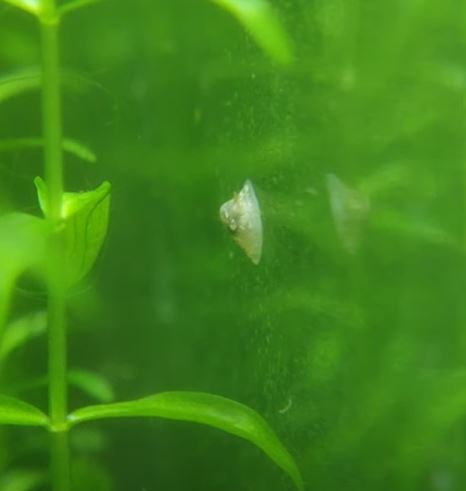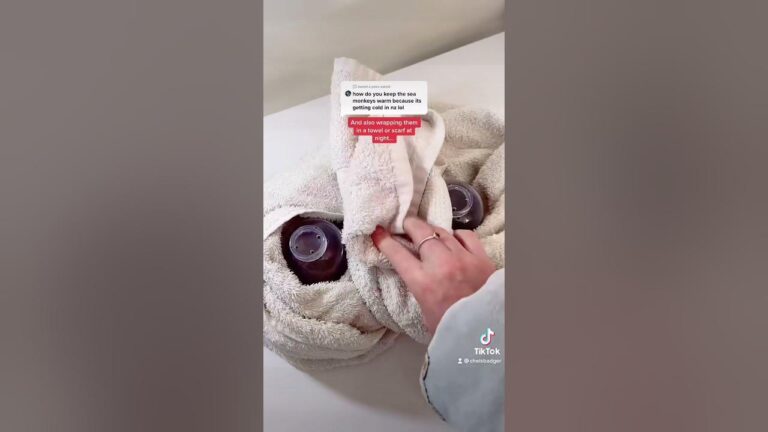How to Get Rid of Limpets in Aquarium?
The best way to get rid of limpets in an aquarium is to manually remove them. Carefully scoop them out with a net and dispose of the limpets away from the tank. You can also take steps to make your aquarium less attractive to limpets such as removing any algae or other organic material they may feed on, vacuuming up debris regularly, and adding more aggressive fish species which will help keep their numbers down.
If all else fails, you can use copper-based treatments that are safe for use in aquariums and have been proven effective at eliminating these pests without harming your other aquatic inhabitants.
- Identify the Limpets: Before attempting to get rid of limpets in an aquarium, it is important to properly identify them. This will help you determine the best way to remove them from your tank
- Remove Water: If possible, remove as much water from your tank as possible. This will make it easier for you to spot and scoop out any limpets that may be hiding within the substrate or decorations.
- Vacuum Substrate: Once most of the water has been removed, use a vacuum cleaner specifically designed for aquariums and vacuums up all of the debris such as dead fish food and algae which can provide sustenance for limpets.
- Use Pesticides: Using substances like copper sulfate or other pesticides can also kill off any remaining limpet population in your aquarium’s ecosystem without harming other aquatic life or plants in your tank. Make sure to read instructions carefully before applying these chemicals into your tank so that they are used safely and effectively.
- Monitor Tank Regularly: After getting rid of the existing limpet population, monitor your tank regularly for signs of new infestations so that action can be taken quickly if necessary!
Freshwater Limpets in Aquarium
Freshwater limpets are an interesting addition to any aquarium. These small snails live on submerged surfaces and feed by scraping off algae and other organic matter. They can help keep your tank clean, as they eat away at debris that would otherwise accumulate in the water.
Although these limpets are not essential for a healthy aquarium, their presence can provide additional filtration benefits while adding some aesthetic variety.
What Eats Limpets in Aquarium?
In aquariums, limpets are commonly preyed upon by various fish such as wrasses and puffers. Certain invertebrates like crabs and shrimp may also feed on them. Limpets should be kept with larger, more aggressive fish that can fend off predators from the smaller species.
It is important to have a suitable tank setup for both the limpets and their predators to ensure they all thrive in their environment.
How to Get Rid of Water Mites in Fish Tank?
If you have water mites in your fish tank, the best way to get rid of them is to use a chemical treatment specifically designed for water mites. Follow the instructions on the product packaging carefully, and make sure all surfaces of the tank and equipment are thoroughly treated.
Additionally, keeping up with regular maintenance such as filter changes can help reduce their numbers. If possible, add some aquarium-safe predators like assassin snails or shrimp that will eat mites while they’re still in their larvae stage.
How To Get Rid Of Freshwater Limpets?
Maintaining a thriving aquarium ecosystem often requires balancing the beauty of underwater life with responsible practices. When faced with invasive freshwater limpets, it’s essential to tackle the issue using methods that not only remove the pests but also prioritize the health of your aquatic environment. I’ll explore practical and eco-friendly methods for eliminating freshwater limpets, ensuring a sustainable and harmonious aquatic ecosystem.
The Eco-Friendly Imperative
Understand why choosing eco-friendly methods for limpet elimination is essential:
- The potential harm of chemical treatments to aquatic life.
- The importance of preserving the balance of your aquarium ecosystem.
- How eco-friendly methods align with responsible aquarium maintenance.
Manual Removal Techniques
Begin with the gentlest approach for eliminating freshwater limpets:
- Using soft brushes or scrapers to remove limpets from surfaces.
- Employing substrate vacuums to target limpets and debris.
- Ensuring minimal disturbance to your aquarium’s residents.
Biological Control
Leverage nature’s allies to combat freshwater limpets while maintaining eco-friendliness:
- Introducing natural predators such as snails and shrimp.
- Adding algae-eating fish to help control limpet populations.
- Creating a balanced ecosystem that discourages limpet infestations.
Natural Habitat Simulation
Learn how to replicate natural habitats to deter limpet growth:
- Adjusting water parameters to be less favorable for limpets.
- Enhancing the underwater environment to mimic limpet-free ecosystems.
- Employing specific plants and decor that limpets find less appealing.
Mechanical Barriers
Explore the use of eco-friendly physical barriers to prevent limpets from spreading:
- Installing fine mesh screens to protect plants and decor.
- Employing specialized substrates that deter limpets from settling.
- Creating physical barriers with aquarium-safe materials.
Prevention and Maintenance
Maintaining an eco-friendly environment is an ongoing commitment:
- The importance of routine water changes and meticulous cleaning routines.
- Continuous monitoring of water parameters to prevent future infestations.
- Aiming for a balanced and self-regulating ecosystem to deter limpet return.
Eco-Friendly Chemical Treatments (As a Last Resort)
If necessary, consider chemical treatments with eco-friendliness in mind:
- Safe and approved eco-friendly chemical options.
- Guidelines for proper dosages and precautions to protect aquatic life.
- Temporary removal of sensitive species during treatment.
The Ecological Responsibility
Reiterate the importance of choosing eco-friendly methods to eliminate limpets:
- The lasting impact of responsible aquarium practices.
- Encouraging fellow aquarists to adopt eco-friendly approaches.
- Preserving the natural beauty of aquatic ecosystems for future generations.
Eliminating freshwater limpets doesn’t have to come at the expense of your aquarium’s health or the environment. By opting for practical and eco-friendly methods, you can achieve limpet removal while upholding your commitment to ecological responsibility.
Remember, an eco-friendly approach not only preserves the delicate balance of your aquatic environment but also promotes sustainable and enjoyable aquarium keeping for years to come.
Freshwater Limpet Size
Freshwater limpets are small aquatic molluscs that can range in size from a few millimeters to approximately 6 cm long. They have conical shells, which vary in coloration and surface texture depending on the species. Freshwater limpets inhabit slow-moving streams, rivers, ponds, and lakes around the world.
These creatures are filter feeders and consume algae by scraping it off of rocks or other objects with their radula (a tongue-like organ).
Are Freshwater Limpets Harmful?
No, freshwater limpets are not harmful to humans. These small mollusks live in slow-moving streams and rivers and feed on algae by scraping off the bottom of rocks. They are an important part of the food chain as they provide a source of nutrition for fish, birds, and other aquatic animals.
While these creatures can be an annoyance if they attach themselves to boats or fishing nets, they pose no threat to people who come into contact with them.

Credit: www.bettafish.com
What Causes Limpets in Aquarium?
Limpets are a type of snail that often find their way into aquariums, and while they can be quite attractive to look at, they can cause some serious problems for your fish. Limpets feed on algae and other organic matter which can quickly deplete the water of its nutrients, leading to an unhealthy environment for your fish.
In addition to this, limpets produce a lot of waste which can further reduce the oxygen levels in the tank and increase ammonia levels.
Furthermore, if you don’t keep up with regular maintenance such as cleaning out debris from filters or gravel vacuuming the substrate regularly then limpets may become overpopulated in an aquarium due to there being plenty of food sources available.
This overcrowding can lead to disease outbreaks amongst your fish population as well as them becoming stressed out by competing for resources within the tank. Therefore it is important that aquarists monitor their tanks regularly so that any signs of limpets are identified early and appropriate steps taken before matters get out of hand!
Are Limpets Good for Aquarium?
Limpets are a great addition to any aquarium. Not only do they add visual interest, but they also help keep the tank clean and provide shelter for other fish. Limpets can be found in saltwater tanks or freshwater tanks, depending on what type of species you choose.
They feed off of algae and other debris that accumulates on rocks and glass surfaces, so they’re often used as part of an effective maintenance routine to keep the aquarium looking its best.
In addition to keeping your tank clean, limpets also provide hiding places for shy fish and act as natural filters by consuming uneaten food particles from the water column before it has a chance to break down into ammonia or nitrates which can be harmful to aquatic life.
As long as you have enough space in your aquarium for them to move around comfortably without overcrowding it with too many specimens, limpets make excellent additions that will benefit both your tank’s inhabitants and overall appearance!
What Kills Limpets?
Limpets are small, sea-dwelling creatures that inhabit rocky shorelines around the world. While they may look harmless, these animals have a surprising number of predators looking to make them their next meal. What kills limpets?
The most common predators are birds such as crows and gulls, but larger fish like cod and bass will also feed on limpets if given the chance. Sea otters have been known to feast on limpets too, often using rocks to break open their shells in order to get at the soft flesh inside.
Humans can also be a threat though not always intentionally as boats or other objects moving through the water can crush or damage limpets in their path.
Despite usually being preyed upon by others, adult limpets do have one natural defence: their tough shell which is designed to protect them from harm.
What Fish Eat Limpets?
Fish that eat limpets include many species of sharks, rays, cod and flatfish. In addition to these predatory fish, some seabirds such as cormorants and gulls prey on limpets in shallow waters. Limpets are found throughout the world’s oceans living in tidal zones on rocky shores where they graze on algae growing on rocks.
They use their hard shell to cling to the rock surface during high tide and move around with a signature rocking motion when foraging for food during low tide. Some kinds of limpets may even be eaten by humans as part of a seafood dish!
Predatory fish feed on them both alive or dead depending upon their preferences and availability. Predators like smooth-hound sharks often bite off pieces from the shell before eating them while others crush the shells with powerful jaws before swallowing them whole.
Freshwater Limpets in Aquarium
Conclusion
The best way to get rid of limpets in an aquarium is through manual removal, chemical treatments, or a combination of both. Manual removal requires patience and diligence to be successful, but it is the safest method for your tank inhabitants. Chemical treatments are more effective and faster when used correctly but may require multiple applications.
It’s important to remember that prevention is always better than cure when it comes to managing pests in an aquarium setting, so take steps like regular maintenance and water changes as well as careful selection of new livestock to reduce the chances of infestation from occurring in the first place!






